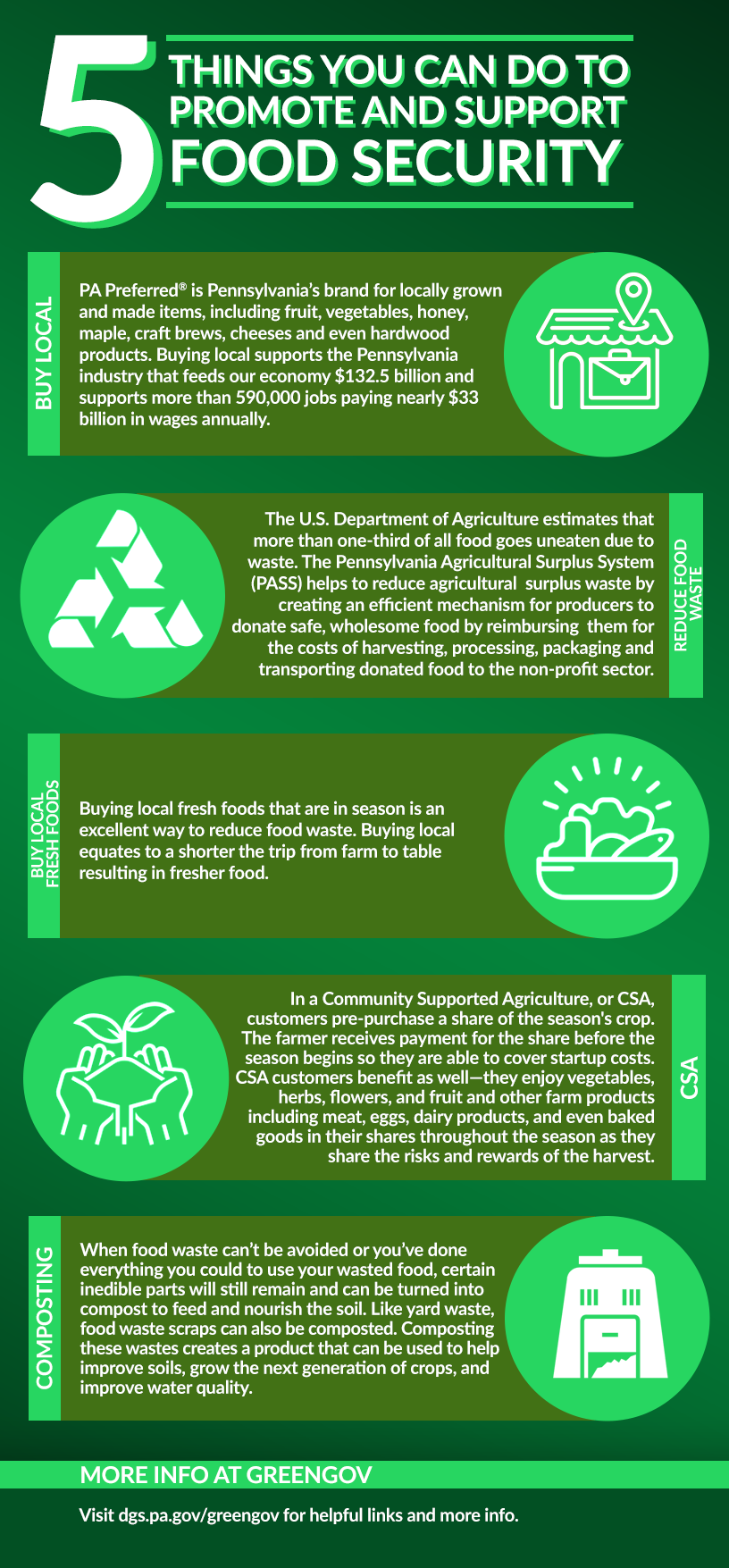 Sustainability Week 2021
Sustainability Week 2021
Food Security, Nutrition & Sustainable Agriculture
Food Insecurity, Nutrition and Benefits of Purchasing Local Foods
Food insecurity in Pennsylvania means not having access to reliable and nutritious meals. Since hunger and health are deeply connected, the effects of chronic hunger are profound. Those effects include increased risks for chronic diseases, higher chances of hospitalization, poorer overall health, and increased health care costs. Adequate access to healthy meals and foods is also critical to child development and success in education so kids can focus in school and lead healthier, more productive lives.
More than 1.5 million Pennsylvanians experienced chronic hunger on a regular basis, including nearly half a million children – a situation that has only been exacerbated with the emergence of the COVID-19 pandemic.
In communities across Pennsylvania and the U.S. there are concerns about access to fresh and healthy foods and produce, as well as the cost of those healthy foods compared to the cost of junk foods. In many cases it may be easier to gain access and afford less healthy foods and nutrition suffers.
However, the commonwealth's strong agricultural heritage and robust industries, alongside its dedication to providing interventions and support to those in need, create a strong foundation for ensuring food security across the commonwealth.
Pennsylvania's Fight Against Food Insecurity
In 2015, Governor Wolf signed an executive order establishing the Governor's Food Security Partnership – sponsored by the Departments of Aging, Agriculture, Education, Community and Economic Development, Health, and Human Services – to coordinate Pennsylvania's food and nutrition programs. By leveraging community and business partners; federal, state, and local resources; and, the charitable food network, the Partnership works to ensure Pennsylvanians have access to nutritious food. Their report, Setting the Table: A Blueprint for a Hunger-free PA, outlined strategies to reduce food insecurity in Pennsylvania communities.
Pennsylvanians receive support and assistance through many ways outside of Pennsylvania's network of nearly 3,000 food pantries, soup kitchens, shelters and other feeding programs that serve more than two million each year.
Some of the more prominent actions and programs undertaken by the Commonwealth of PA include:
-
Pennsylvania Agricultural Surplus System (PASS) program helps to support Pennsylvania's agriculture industry and reduce waste of agricultural surplus by making connections between production agriculture and the non-profit sector. Originally enacted into law in 2010, the program was first funded in 2015 by Governor Tom Wolf at $1 million annually. In 2017-18, the program funding was increased to $1.5 million annually.
- Ensuring access to the
Supplemental Nutrition Assistance Program (SNAP) that helps Pennsylvanians buy food. People in eligible low-income households can obtain more nutritious diets through SNAP, which can increase their food purchasing power at grocery stores and supermarkets.
- Creating sustainable food resources through the
PA Farm Bill, a comprehensive set of programming and funding for Pennsylvania's agriculture industry. The Farm Bill's Urban Agriculture Grant Program provides funding for projects including everything from refrigeration equipment to agricultural infrastructure such as greenhouses, raised beds, irrigation, and tools to provide urban ag operations every opportunity to succeed as they work to feed and build their communities.
- For a more comprehensive overview of Commonwealth of Pennsylvania Actions taken to fight food insecurity visit the
PA Food Security Page hosted by the PA Department of Agriculture
What Can You Do to Promote and Support Food Security?
-
Buy local –
PA Preferred® is Pennsylvania's brand for locally grown and made items, including fruit, vegetables, honey, maple, craft brews, cheeses and even hardwood products. Buying local supports the Pennsylvania industry that feeds our economy $132.5 billion and supports more than 590,000 jobs paying nearly $33 billion in wages annually.
-
Reduce food waste.
The U.S. Department of Agriculture estimates that more than one-third of all food goes uneaten due to waste. The Pennsylvania Agricultural Surplus System (PASS) helps to reduce agricultural surplus waste by creating an efficient mechanism for producers to donate safe, wholesome food by reimbursing them for the costs of harvesting, processing, packaging and transporting donated food to the non-profit sector.
-
Buying local fresh foods that are in season is an excellent way to reduce food waste. Buying local equates to a shorter trip from farm to table resulting, the in fresher food. Find out what foods are in season using our
fresh foods calendar.
-
Another way to buy locally and support local agriculture is
Community Supported Agriculture, or CSA. In a CSA, customers pre-purchase a share of the season's crop. The farmer receives payment for the share before the season begins so they are able to cover startup costs. CSA customers benefit as well--they enjoy vegetables, herbs, flowers, and fruit and other farm products including meat, eggs, dairy products, and even baked goods in their shares throughout the season as they share the risks and rewards of the harvest. Find out more at the
Penn State Community Supported Agriculture site.
-
Composting.
When food waste can't be avoided or you've done everything you could to use your wasted food, certain inedible parts will still remain and can be turned into compost to feed and nourish the soil. Like yard waste, food waste scraps can also be composted. Composting these wastes creates a product that can be used to help improve soils, grow the next generation of crops, and improve water quality. You can compost at home using this
Composting at Home Guide from the US Environmental Protection Agency.
Let Us Know About Your Event!
Register a Sustainability Event or Action Today
Download the Infographic

Click here to download the Food Security infographic.